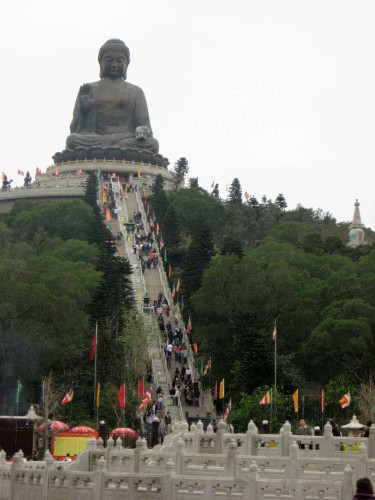Three months in, I had done most of the “you gotta go see/do this if you’re a tourist” things in Hong Kong. Dim sum at Maxim’s, Lan Kwai Fong at 1 a.m., the tram to Victoria Peak, the tunnel to Repulse Bay and Stanley, high tea at the Peninsula Hotel, the laser light show over Victoria Harbour.
Pretty much had checked off all the boxes.
All except one.
The Big Buddha.
And, no I’m not talking about Shaquille O’Neal, though he may well have referred to himself by that name, now and again. It sounds like something he would come up with.
The Big Buddha is an enormous bronze statue of the ancient religious figure built on the island of Lantau, which is part of greater Hong Kong. And if you’re a tourist … you pretty much have to go see the Big Buddha. It’s the law.
Today was the day. And the whole thing surprised me a little.
For example:
This isn’t some historical site. The statue certainly isn’t, having been completed fewer than 20 years ago. I just assumed it was ancient. Nope.
I knew this was more of a tourist thing than a religious thing. But I didn’t know how much of a tourist thing it is.
The area around the Buddha is a sort of Disneyland-like collection of themed shops, with kitschy art and crafts of all sort. You can pay to see a movie entitled, “A Walk with Buddha.” You can buy Buddha dolls and statuettes.
Now granted, the Vatican, inside Rome, has some of that … but most of the cheesy souvenirs are outside the Vatican walls. Around the Big Buddha, you could buy postcards and joss sticks a few feet from the main temple — which is down at ground level.
Also, one of the two primary ways to reach the Big Buddha, once you have taken the Tung Chung metro line to its end (about a 30-minute ride from Central, on Hong Kong Island), is a cable car — which is anything but humble. The ride to Ngong Ping, the Disneyesque Mainstreet USA town at the foot of the Buddha, costs about $20 roundtrip, which is no bargain in these parts. Though it is quite scenic, as we saw by riding it down. On the way up, we embraced self-denial, taking the bus for $2.30. Though it was a stop-and-go, one-lane thrill ride that also might make a person queasy.
Also, the Big Buddha has Asian features, which is interesting. Because the Buddha was a man who lived some 2,500 years ago (that is, before Jesus of Nazareth) and was from India.
We tend to have images of a Buddha with a tubby tummy. But this one is quite svelte.
Perhaps the greatest action of devotion to the Buddha is climbing up to see him up close — though he allegedly can be seen from Macao, on a clear day. By my count it is 250 steps up to the base of the statue — equivalent to climbing up about 25 stories. A serious hike. No escalator, no elevator. Though there is a service road for workers and the handicapped.
I expected a few more outward signs of religious devotion, but what I saw was limited to a brief period of half-a-dozen monks chanting in the main temple, at the monastery down the hill … and a handful of Chinese buying joss sticks to burn, and wave, and to hold while praying.
In that sense, it was semi-sad … a “where are the believers?” moment that brings to mind the museum-like cathedrals of Europe. Which also attract far more tourists than believers.
We had lunch in a place named “Euro” where I had the spaghetti with ham for $4. Leah bought a scarf. I would have bought a “Big Buddha” cap, but they didn’t appear to sell them, and I wondered why they apparently got cold feet there.
Buddhism is interesting, in religious history. It began in India, was the dominant religion there a thousand or so years ago, then suffered persecution by indiginous Hindus and invading Muslims, and now is nearly extinct in the land of its birth.
However, it remains the preferred religion in several Asian countries, particularly in Thailand, Cambodia and Myanmar, and has strong followings in Vietnam and Japan.
It once was thriving in China, but many emperors saw it as a foreign invention and persecuted Buddhists, and the Communists aren’t keen on any religion at all, and that combination of factors dented its numbers seriously, in terms of “percentage of the population.” Still, the greatest number of Buddhists in any one country is China, which is estimated to have more than 100 million Buddhists (about 10 percent of all Chinese), and they comprise nearly one-third of the world’s 350 million.
The Big Buddha: Do I recommend it? Actually, no. It is a logistical challenge (figure three hours in transit, from HK Island and back), it isn’t particularly moving or dignified — because it is so touristy.
But, you have to do it. So you can say “yes” when someone asks, “Did you see the Big Buddha?” And now I have.


0 responses so far ↓
There are no comments yet...Kick things off by filling out the form below.
Leave a Comment